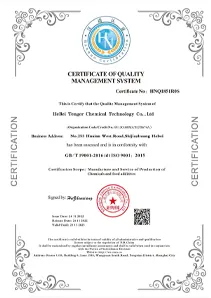
e270 food additive
Understanding E270 A Common Food Additive
E270, also known as lactic acid, is a widely used food additive that plays a significant role in various food products. It is considered safe for consumption and is naturally found in fermented foods. This article delves into the origins, uses, and health implications of E270.
Origins of E270
Lactic acid is an organic acid that occurs naturally during the fermentation process. It is produced by certain bacteria and is a byproduct of carbohydrate metabolism. Lactic acid bacteria, such as Lactobacillus, thrive in environments rich in sugars, converting them into lactic acid. This process not only preserves food but also enhances its flavor. In this way, E270 can be found in yogurt, pickles, sauerkraut, and various dairy products.
Uses in Food Products
E270 serves multiple functions in the food industry, making it an essential additive. Primarily, it acts as a preservative, helping to prolong the shelf life of products by inhibiting the growth of harmful bacteria and molds. Additionally, lactic acid is commonly used to regulate pH levels in food items, improving their flavor and texture. It can be found in a variety of products, including
e270 food additive

- Dairy Products Yogurt and cheese often contain lactic acid, contributing to their tangy taste and enhancing their creamy texture. - Beverages E270 is used in sodas, juices, and alcoholic drinks to provide a slight acidity and balance flavors. - Processed Foods Many snacks, sauces, and deli meats utilize lactic acid to improve taste and preserve freshness. - Baked Goods In baked products, lactic acid can enhance acidity, which helps in the fermentation process, resulting in better texture and flavor.
Health Implications
The use of E270 is generally recognized as safe (GRAS) by food safety authorities, including the FDA and the European Food Safety Authority (EFSA). As a naturally occurring substance, it poses minimal health risks when consumed in moderate amounts. Moreover, lactic acid is beneficial for gut health; it may support the growth of beneficial gut bacteria. However, individuals with lactose intolerance or specific allergic reactions should be cautious, as certain lactic acid sources may be derived from milk.
Conclusion
E270, or lactic acid, is a versatile food additive that enhances flavor, preserves food, and supports various culinary processes. Its natural occurrence in fermented foods underlines its safety and health benefits. While it is essential to be aware of its sources and effects, E270 remains an integral part of the food industry, contributing to the quality and longevity of many beloved products. As consumers become more health-conscious, understanding additives like E270 can empower them to make informed choices about the foods they consume. Whether found in a cup of yogurt or a bottle of soda, lactic acid continues to play a vital role in our diets, merging taste with preservation in the culinary world.
-
nitrile-rubber-honoring-strict-production-standardsNewsAug.22,2025
-
aspartame-ingredients-honoring-food-safety-valuesNewsAug.22,2025
-
fertilizer-for-balanced-plant-nutritionNewsAug.22,2025
-
cyanide-gold-processing-with-high-purity-additivesNewsAug.22,2025
-
formic-acid-in-textile-dyeing-applicationsNewsAug.22,2025
-
aluminum-hydroxide-gel-in-skincare-productsNewsAug.22,2025
-
Regulatory Compliance for Global Mining Chemicals UseNewsAug.12,2025
Hebei Tenger Chemical Technology Co., Ltd. focuses on the chemical industry and is committed to the export service of chemical raw materials.
-

view more DiethanolisopropanolamineIn the ever-growing field of chemical solutions, diethanolisopropanolamine (DEIPA) stands out as a versatile and important compound. Due to its unique chemical structure and properties, DEIPA is of interest to various industries including construction, personal care, and agriculture. -

view more TriisopropanolamineTriisopropanolamine (TIPA) alkanol amine substance, is a kind of alcohol amine compound with amino and alcohol hydroxyl, and because of its molecules contains both amino and hydroxyl. -

view more Tetramethyl Thiuram DisulfideTetramethyl thiuram disulfide, also known as TMTD, is a white to light-yellow powder with a distinct sulfur-like odor. It is soluble in organic solvents such as benzene, acetone, and ethyl acetate, making it highly versatile for use in different formulations. TMTD is known for its excellent vulcanization acceleration properties, which makes it a key ingredient in the production of rubber products. Additionally, it acts as an effective fungicide and bactericide, making it valuable in agricultural applications. Its high purity and stability ensure consistent performance, making it a preferred choice for manufacturers across various industries.





